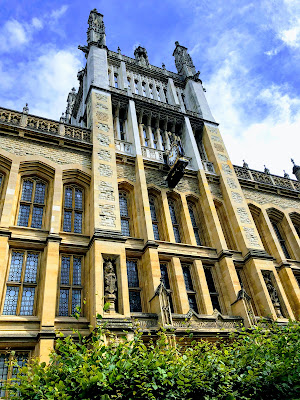The King's College Building
The Maughan Library Collections
Today we are visiting the Maughan Library of King's College (Strand Campus on Chancery Lane). The building, originally a property of King Henry II, was built around 1,232. It served as the "House of Converts" and the "Rolls Estate" where large scrolss were kept here. Around 1,851 it functioned as Public Record Office institution. The Rolls Estate became later the Maughan library.The Public Record Office Room
We toured the Public Record office room. We walked around long cast iron shelves built to withstand fire to protect the paper reocrds. It was known as one of the most fire proof rooms in England.The Weston Room or the Rolls Chapel
The Weston Room used to be the residence of the Master of the Rolls. There was a chapel which this is a remainder of the Rolls Chapel. The windows and the mosaic were restored in the fifties. This is one of the statutes in memory of one of the two master rolls.Special Collections : Rare collections
The Head of Special Collections of the Maughan Library and three librarians greeted us. They directed us to the Foyle Special Collections area. This is the room where rare items are stored.There are about 200 thousand items dating from the fifteen century. Most of these relate to Humanities, Social Sciences and Theological subjects. One of the many rare items that are housed in this repository are: a translation of the Tamul (New Testament) by Mr. William Marsden, a book about the quest for conquering Mexico and Peru from the 1600's, medical collections from St. Thomas Hospital, a book signed by Benjamin Franklin.
Preservation and Cataloguing of items
The librarian talked about the challenges of preserving the physical books especially the ones dated from the 1700's. She mentioned the importance of recording and preserving the provenance of each item. As an example, she had two apparentlly exact copies of a book, same edition from 1739. However, one required more recording and cataloguing than the other since it had to capture contextual and descriptive information about one of the books that had a dedication, a signature and annotations, and how it ended up being part of the Library's collection. When the book was bequeathed, the librarian found in one of the books a letter hiding in a glued sheet next to the end cover. The letter was addressed to a person believed to be a person of nobility exiled in Rome, so this had to be recorded in the catalog.
Other items that are challenging to preserve are scrapbooks of the Queen's coronation, the spine is not strong enough to support the weight of the pictures. Another item is a magazine that had to be digitized and made a surrogate to preserve it so it can be accessed by researchers. Lastly, there is a book with the original crib sheets used by people from the resistance to infiltrate Nazi meetings. These are encased in hard plastic to prevent the paper from crumbling and are bound in a hard case so these can be exhibited.
Promoting the Collection
Adam talked about the activities and promotion efforts to engage with researchers, some of these include: teaching seminars, events exhibits, internships. I learned that whenever they do online exhibitions they digitize the items to make them accessible. Creating surrogates is a way to prolong the life of the items in the collection. He mentioned one intern dedicated one hundred hours researching physical formats and another intern researching historical contexts, representation of attituteds and values of the British Empire. He will display and present his findings via online exhibitions. Another research involved exploring colonial medicine and industrial development of entrepeneurs using forced labor.
The golden nugget of my visit today: The Recording of Provenance of Incunabula Books in Europe via a (scholar) CERL database
I learned about the types of Incunabula Books found in the Foyle Special Collections. These are dated from at least the 1,500's. The library has at least 17 incunabula books in the collection. One intern did research on the provenance of these rare books. Her findings are of interest for the archives itself and the community of scholars. She tracked the provenance into a Consortia of European Academic Research Libraries -CERL database, "Material Evidence inIncunabula" in which scholars and researchers enter every possible detail about the incunabula book:
"Every item of data recorded (a certain style of decoration or binding, the date of a manuscript note, etc.) is treated as a valuable clue for provenance, therefore it can be geographically located and chronologically dated. This enables to track the movement of books across Europe and through the centuries." (Material Evidence in Incunabula- CERL Website).
This was a learning experience for me. I had not idea such database existed and I see the inmense value for archival institutions to be on board documenting the provenance of its rare incunabula items.
References:
King's FCO Historical Collection
Online Exhibitions of Special Collections. Retrieved from: http://www.kingscollections.org/exhibitions/specialcollections/
Special Collection:s Online Exhibitions. Incunabula. King's College. Retrieved from http://www.kingscollections.org/exhibitions/specialcollections/incunabula/
Material Evidence in Incunabula. Consortium of European Research Libraries Database. (CERL). Retrieved from https://data.cerl.org/mei/_search




Comments
Post a Comment